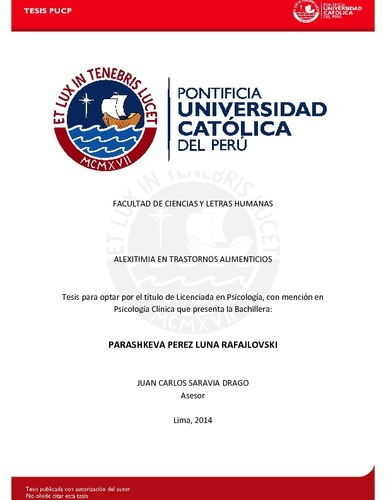| dc.contributor.advisor | Saravia Drago, Juan Carlos | es_ES |
| dc.contributor.author | Perez Luna Rafajlovski, Parashkeva | es_ES |
| dc.date.accessioned | 2014-08-28T01:55:59Z | es_ES |
| dc.date.available | 2014-08-28T01:55:59Z | es_ES |
| dc.date.created | 2014 | es_ES |
| dc.date.issued | 2014-08-27 | es_ES |
| dc.identifier.uri | http://hdl.handle.net/20.500.12404/5548 | |
| dc.description.abstract | El presente estudio buscó comparar la Alexitimia y sus características entre un grupo clínico conformado por pacientes con Trastornos Alimenticios (TA) y un grupo de contraste sin trastornos mentales diagnosticados. Se evaluó a 38 participantes que presentaban Trastornos Alimenticios, quienes fueron hallados en dos instituciones hospitalarias y presentaban edades entre 20-22 años. Se utilizaron pruebas no paramétricas para el tratamiento de los datos.
Se planteó la hipótesis que los pacientes con TA que participaron de esta investigación podrían presentar Alexitimia debido a la dificultad para reconocer o identificar a cabalidad lo que sucede dentro de ellos
Los resultados mostraron que los pacientes con TA obtuvieron puntuaciones más altas en la escala de Alexitimia, en comparación con el grupo contraste. Se hallaron similitudes entre las características propias de los TA y la Alexitimia, tales como los tres factores determinados en el TAS, además de la impulsividad manifestada en la toma de decisiones irreflexivas y la tendencia a establecer relaciones interpersonales estereotipadas.
Se concluye entonces que existe una gran similitud entre los TA y la Alexitimia y que tal como se había considerado inicialmente, existe un incremento en los niveles de Alexitimia en los pacientes con TA. | es_ES |
| dc.description.abstract | The present study attempted to compare Alexithymia and its characteristics between a clinical group made up of patients with Eating Disorders (ED) and a control group with no diagnosed mental conditions. 38 participants presenting Eating Disorders, who were found in two hospital institutions and were in the 20-22 age group, were evaluated. Non-parametrical tests were used for the treatment of data.
The hypothesis set forth is that patients with ED who participated in this investigation could present Alexithymia due to the difficulty in fully recognizing or identifying what occurs within them.
The results showed that patients with ED achieved scores higher in the Alexithymia scale, in comparison with the control group. Similarities were found between the characteristics of EDs and Alexithymia, such as the three factors determined in the TAS, the impulsiveness manifested in the taking of rash decisions, and the tendency to establish stereotypical interpersonal relationships.
The conclusion, then, is that there is a great similarity between EDs and Alexithymia, and just as was initially considered, there is an increase in Alexithymia levels between patients with EDs. | es_ES |
| dc.language.iso | spa | es_ES |
| dc.publisher | Pontificia Universidad Católica del Perú | es_ES |
| dc.rights | Atribución-NoComercial-SinDerivadas 2.5 Perú | * |
| dc.rights | info:eu-repo/semantics/openAccess | es_ES |
| dc.rights.uri | http://creativecommons.org/licenses/by-nc-nd/2.5/pe/ | * |
| dc.subject | Alexitimia | es_ES |
| dc.subject | Trastornos de la nutrición--Pacientes. | es_ES |
| dc.title | Alexitimia en trastornos alimenticios | es_ES |
| dc.type | info:eu-repo/semantics/bachelorThesis | es_ES |
| thesis.degree.name | Licenciado en Psicología Clínica | es_ES |
| thesis.degree.level | Título Profesional | es_ES |
| thesis.degree.grantor | Pontificia Universidad Católica del Perú. Facultad de Letras y Ciencias Humanas. | es_ES |
| thesis.degree.discipline | Psicología Clínica | es_ES |
| renati.discipline | 313026 | es_ES |
| renati.level | https://purl.org/pe-repo/renati/level#tituloProfesional | es_ES |
| renati.type | http://purl.org/pe-repo/renati/type#tesis | es_ES |
| dc.publisher.country | PE | es_ES |
| dc.subject.ocde | https://purl.org/pe-repo/ocde/ford#5.01.00 | es_ES |






